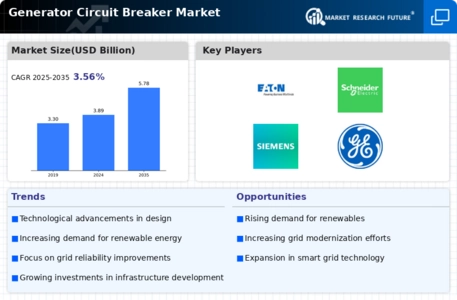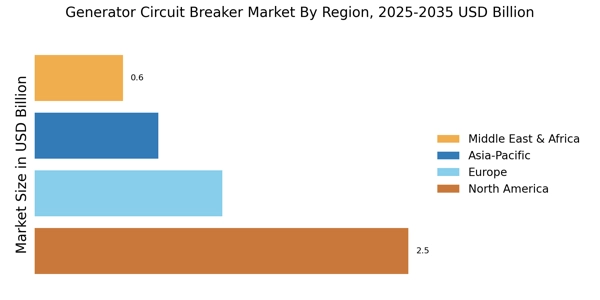Expansion of Renewable Energy Projects
The Generator Circuit Breaker Market is significantly influenced by the expansion of renewable energy projects. As nations strive to meet sustainability goals, investments in solar, wind, and hydroelectric power generation are on the rise. This shift towards renewable energy sources necessitates the implementation of advanced circuit protection solutions to ensure the safe and efficient operation of these systems. The market for generator circuit breakers is expected to witness substantial growth, with projections indicating an increase in demand by over 20% in the next five years, driven by the need for reliable protection in renewable installations. Additionally, the integration of generator circuit breakers in renewable energy projects enhances grid stability and facilitates the transition to cleaner energy sources, thereby reinforcing the importance of this market.
Rising Demand for Reliable Power Supply
The Generator Circuit Breaker Market is experiencing a notable surge in demand for reliable power supply solutions. This trend is primarily driven by the increasing need for uninterrupted electricity in various sectors, including industrial, commercial, and residential. As economies expand, the reliance on stable power sources intensifies, leading to a greater emphasis on advanced circuit protection technologies. The market is projected to grow at a compound annual growth rate of approximately 6.5% over the next few years, reflecting the urgency for enhanced power reliability. Furthermore, the integration of smart technologies into power systems necessitates the use of sophisticated generator circuit breakers, which can effectively manage and mitigate power fluctuations. This growing demand for dependable power infrastructure is likely to propel the Generator Circuit Breaker Market forward.
Technological Innovations in Circuit Protection
The Generator Circuit Breaker Market is benefiting from rapid technological innovations in circuit protection solutions. Advances in materials science and engineering have led to the development of more efficient and reliable circuit breakers that can withstand higher voltage levels and provide enhanced protection against electrical faults. These innovations are crucial as they align with the increasing complexity of modern electrical systems, which require sophisticated protection mechanisms. The market is projected to expand by approximately 8% over the next few years, driven by the demand for cutting-edge technologies that improve safety and operational efficiency. Furthermore, the integration of digital technologies, such as IoT and smart monitoring systems, into generator circuit breakers is likely to revolutionize the industry, offering real-time data and analytics for better decision-making.
Increased Investment in Infrastructure Development
The Generator Circuit Breaker Market is poised for growth due to increased investment in infrastructure development across various regions. Governments and private entities are allocating substantial resources to modernize and expand electrical grids, which is essential for accommodating growing energy demands. This trend is particularly evident in emerging economies, where urbanization and industrialization are driving the need for robust power distribution systems. The market is anticipated to grow by approximately 7% annually as infrastructure projects necessitate the installation of advanced generator circuit breakers to enhance system reliability and safety. Moreover, the focus on upgrading aging electrical infrastructure further underscores the critical role of generator circuit breakers in ensuring efficient power distribution, thereby propelling the market forward.
Regulatory Frameworks Supporting Energy Transition
The Generator Circuit Breaker Market is significantly shaped by regulatory frameworks that support the transition to cleaner energy sources. Governments worldwide are implementing policies and regulations aimed at reducing carbon emissions and promoting energy efficiency. These initiatives often require the adoption of advanced circuit protection technologies, including generator circuit breakers, to ensure compliance with safety and environmental standards. The market is expected to grow by around 5% annually as regulatory pressures drive the need for modernized electrical systems. Additionally, incentives for renewable energy projects and energy efficiency improvements further bolster the demand for generator circuit breakers, highlighting their essential role in facilitating the energy transition.


















Leave a Comment